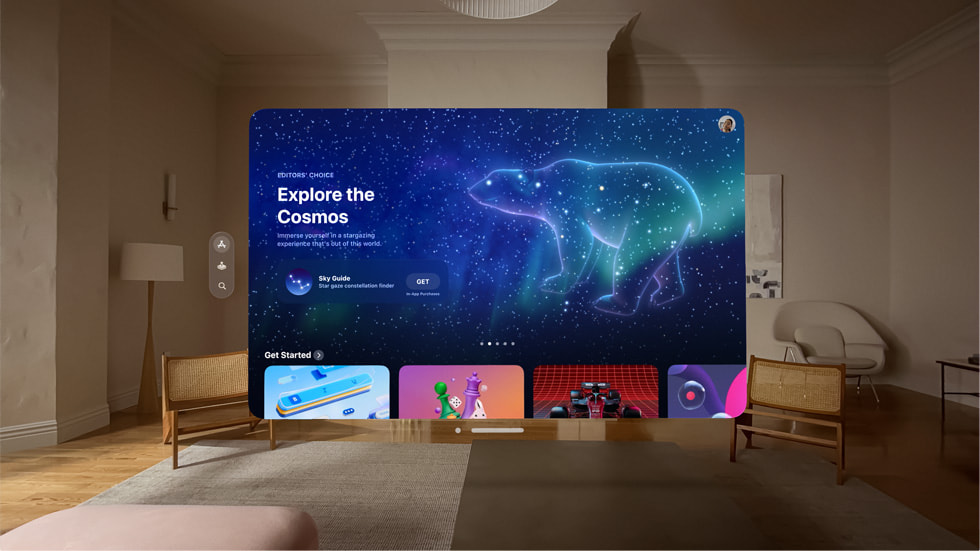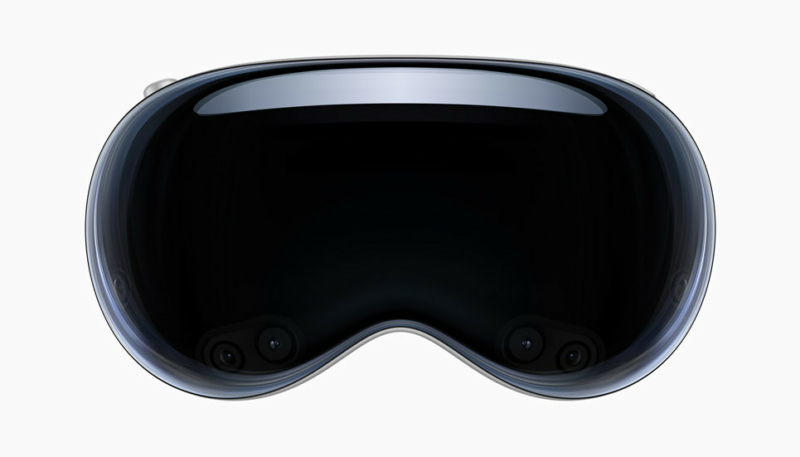Apple today unveiled its Apple Vision Pro, which Apple refers to as “a revolutionary spatial computer that seamlessly blends digital content with the physical world while allowing users to stay present and connected to others.”
The Apple Vision Pro operating system is called “visionOS,” which the Cupertino firm says is the world’s first spatial operating system, designed to allow users to interact with digital content so that it feels like it is physically present in their space.
visionOS features a three-dimensional interface. Users can adjust apps at any scale while placing apps wherever they’d like. A combination of a user’s eyes, hands, and voice is used to control the device. Users can browse through apps, tap their fingers to select, flick their wrist to scroll, or use voice to dictate. The headset is also compatible with Apple’s Magic Keyboard and Magic Trackpad.
The front of the headset is made of polished glass, encased in a lightweight aluminum frame. The headset features a Digital Crown and a button, both of which can be used to control how immersed a user is in a virtual environment.
The headset’s frame curves around a user’s face and the headsets modular system allow a proper fit for a wide range of head sizes and shapes. The headset is powered by a separate battery that connects to the headset via a magnetic connection on the side of the unit. The headset is capable of running for two hours on a single charge.
A singular piece of three-dimensionally formed and laminated glass is polished to create an optical surface that acts as a lens for the wide array of cameras and sensors needed to blend the physical world with digital content. The glass flows into the custom aluminum alloy frame that gently curves around the user’s face, while the modular system allows for a tailored fit to accommodate a wide range of people. The Light Seal is made of a soft textile, and comes in a range of shapes and sizes, flexing to conform to a user’s face for a precise fit. Flexible straps ensure audio remains close to the user’s ears, while a Head Band — available in multiple sizes — is three-dimensionally knitted as a single piece to provide cushioning, breathability, and stretch. The band is secured with a simple mechanism, making it easy to change to another size or style of band.
Unfortunately for glasses wearers, they’ll be required to purchase and use magnetic prescription ZEISS glass inserts with the headset, ensuring they can properly enjoy the Vision Pro’s ultra-high-resolution display that includes 23 million pixels across two micro-OLED displays, providing a better than 4K experience.

Vision Pro boasts an array of high-speed cameras working with a ring of LEDs that project invisible light patterns on the user’s eyes, allowing it to track their gaze.
The headset is powered by an M2 chip, which works with a brand-new “R1” chip, which is dedicated to real-time sensor processing. The R1 chip processes input from 12 cameras, five sensors, and six microphones to ensure that content feels like it is appearing right in front of the user’s eyes, in real-time. Apple says the R1 streams new images to the displays within 12 milliseconds — 8x faster than the blink of an eye.
A new spatial audio system includes two individually amplified drivers in each audio pod. The system provides Personalized Spatial Audio, based on the user’s own head and ear geometry.
The headset’s “EyeSight” feature provides passthrough video of a wearer’s eyes to people surrounding them. A lenticular OLED display shows the correct perspective to anyone viewing the user.

The headset allows users to transform their surrounding space into a personal movie theater, allowing them to become more immersed in videos. Vision Pro can also connect to a user’s Mac, expanding its display to a virtual space, where the Mac’s apps run alongside the apps running on the Vision Pro itself.
When using FaceTime with the headset, everyone on the call is represented in life-sized tiles, while those participants will see the headset wearer as a Persona, which is a digital representation of the headset user.
Headset security is handled by “Optic ID,” which uses a wearer’s iris to authenticate and unlock the headset.
The Vision Pro starts at $3,499 and it will hit shelves early next year. It will initially be available only in U.S. Apple retail stores.
The Vision Pro’s operating system is known as “visionOS.” The new operating system features a new three-dimensional interface that makes digital content look and feel present in a user’s physical world.
By responding dynamically to natural light and casting shadows, it helps the user understand scale and distance. To enable user navigation and interaction with spatial content, Apple Vision Pro introduces an entirely new input system controlled by a person’s eyes, hands, and voice. Users can browse through apps by simply looking at them, tapping their fingers to select, flicking their wrist to scroll, or using voice to dictate.
iPhone and iPad apps are compatible with visionOS, ensuring there will be a large number of apps available at launch. A new App Store will allow users to easily discover visionOS apps.


